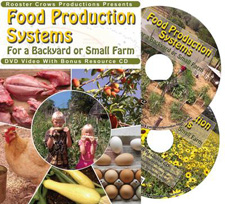 Gaye Levy, Contributing Writer
Gaye Levy, Contributing Writer
Activist Post
At one time or another, every prepper will ask him or herself: could I become 100% self-reliant in terms of proving food for myself and my family? And most of us will say, no, that is not possible.
Today I would like you to re-think that proposition because, with time, planning, and a bit of luck, it is possible if not always practical. But let me start at the beginning.
Food Production Systems for A Backyard or Small Farm
A few weeks ago I invited some like-minded friends over for a survival meal made from my items in my food storage and a viewing of the DVD: Food Production Systems for a Backyard or Small Farm The four of us watched the DVD from start to finish with many pauses for discussion points and to take notes. So what did we think?
Well first of all, let me say that this is a pretty amazing DVD in that it covers so much in just a couple of hours. And while the DVD itself does not go in to extensive detail about the various topics, the included resource DVD does. Perhaps it is best to start with an outline of the DVD itself plus a 3-minute trailer.
Section 1: Overview
- Why we began this journey
- Soil types and climate of the site
Section 2: Water
- Water sources and qualities of water
- How much water do you need?
- Rain water collection systems
- Wells
- Ponds
Section 3: Garden
- Garden location
- Size – how much area do you need?
- Bio-Intensive gardening overview
- Fertility
- Watering the garden
- Wind
- Sun and shade
- Bugs and insects
- Vegetable varieties and seed saving
- Getting started
Section 4: Rabbits
- Housing and protection
- Watering systems
- Feeding
- Breeds
- Reproduction
- Other resources
Section 5: Home Butchering
- Tools
- Butchering a rabbit
- Tanning hides
- Butchering poultry
- Other animals
Section 6: Poultry
- Chicken breeds
- Feeding
- Watering
- Housing and egg collecting
- Predator protection
- Getting started
Section 7: Dogs
- Why dogs?
- Dog training
- Feeding
- Housing
- Size and breeds
- Final thoughts
Section 8: Perennials: Orchards, Food Forests, and Edible Landscaping
- Locations and micro climates
- Watering
- Fertility
- Using geese for fertility
- Tree varieties
- Planting and care of trees
- Getting started
Section 9: Other Essentials
- Calorie crops
- Solar food dehydration
- Home made herbicide test
- Fire ants
- Injuries
- Hog panels and tee posts
- Water levels and mapping contours
- Rocket stove and hay box cooker
- In The Wake; a manual for outliving civilization
- Propagating leuceana
As you look through these topics, you will see that almost every aspect of food production is covered. From figuring our your water needs, to selecting chickens and your coop, to determining the correct type of fruit trees for your orchard, there are practical tips that every one can embrace. (Personally, though, I did fast forward through the butchering section.)
So what is my takeaway?
The author, Marjory Wildcraft is a down-to-earth, practical lady that has learned what works and what does not work through trial and error on her own homestead. She is not a Hollywood actor hired to make the DVD sparkle visually. Instead, she walks us through her own hand on efforts to attain sustainability, dirty fingernails and all.
Something of Value for Newbies
The most valuable part of the DVD for myself and my dinner companions were her tips for beginners:
- Plan your garden. What is your climate? What grows well in your area? Ask other gardeners in your community for advice while you are in the planning stage.
- Start small or you will be overwhelmed and will give up. Even starting with a few pots on a deck is better than nothing.
- Determine your water needs in advance and install water systems (she shows you how).
- Beginners should start with nursery starts and not seeds (now that was surprising!)
- Do not be afraid of failure. It takes trial and error to figure out the nuances of what will work in your geographical area and your circumstances. Plus, it takes time to develop the proper technique
- Grow for calories. If you are looking for 100% self-reliance, calories are important
- Chickens are for egg-laying and not for meat. Unless you can handle 90 chickens at a time, that is.
And for the more advanced gardener? Watch the DVD again and pick up information that was over your head when you watched it the first time. The material is timeless and the resource DVD invaluable in provided references to the more esoteric how-to’s and why-for’s.
If I can site any negatives it would have to do with the fact that a lot of emphasis was given on dealing with the very hot climate in the south – in this case it was Texas. I feel the DVD could have used a section of gardening and producing food when the growing season is short such as here in Washington state.
The DVD also assumes that you have a decent-sized area for a garden, say 10 x 20 or larger. Those limited to a smaller plot or containers would be better off sticking to books, such as the Square Foot Gardening book that I love so much.
That said, after watching this DVD I am going to rethink my seed-starting process and do a better job of composting.
The Final Word
If you have never done any gardening, do not shy away from this DVD. There are so many practical, no BS tips that this DVD can take you from beginner to expert over a period of time. As a matter of fact, Marjory indicates that failure is part of the process and even she is still learning.
Wise words from a smart lady.
Enjoy your next adventure through common sense and thoughtful preparation!
Gaye
. . . Your comments welcome here and at The Buzz.
PS: After writing this review, I was informed by Marjory and Jon of the following: “The DVD set is being re-packaged under the name Grow Your Own Groceries. In addition, it will be bundled with the John Jeavons’ book, How to Grow More Vegetables, which is essentially a must-have for its information on soil fertility and efficient plant spacing. The bio-intensive method is used by Marjory in the DVD, which she mentions and features. “
They assure me that this is exactly the same DVD as Food Production Systems for a Backyard or Small Farm which is still available on Amazon for about $58.
Read other articles by Gaye Levy here.
Gaye Levy, the SurvivalWoman, grew up and attended school in the Greater Seattle area. After spending many years as an executive in the software industry, she started a specialized accounting practice offering contract CFO work to emerging high tech and service industries. She has now abandoned city life and moved to a serenely beautiful rural area on an island in NW Washington State. She lives and teaches the principles of a sustainable, self-reliant and stylish lifestyle through emergency preparation and disaster planning through her website at




Be the first to comment on "How to Grow and Raise 100% of Your Food"